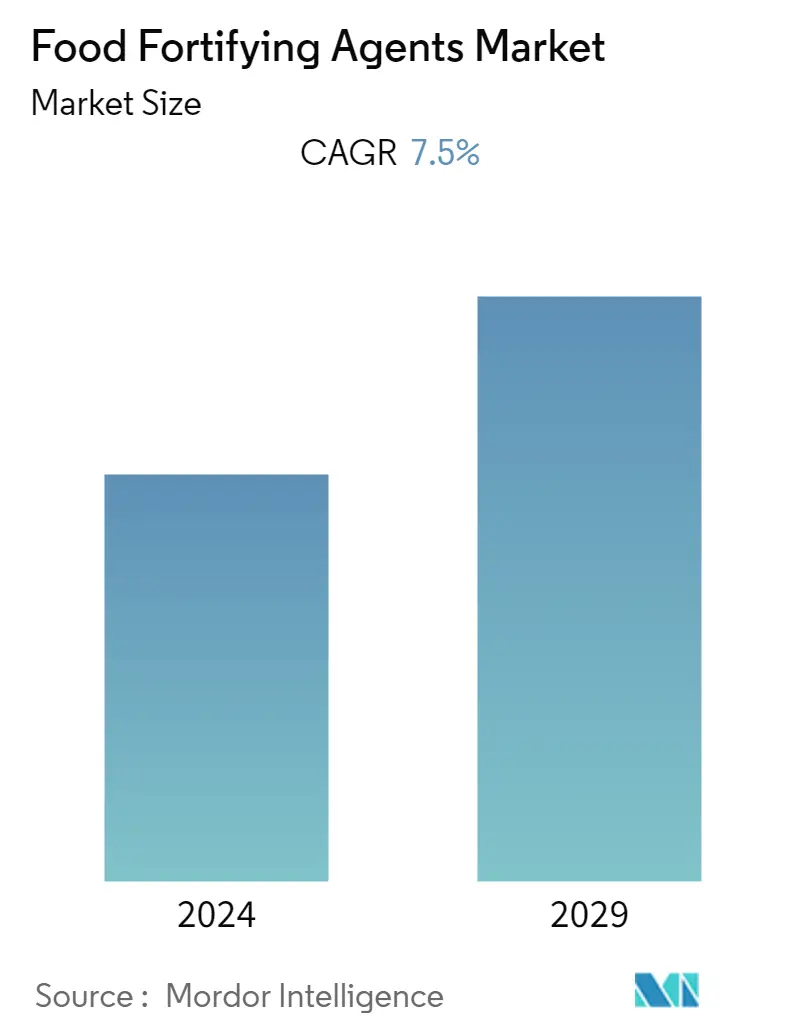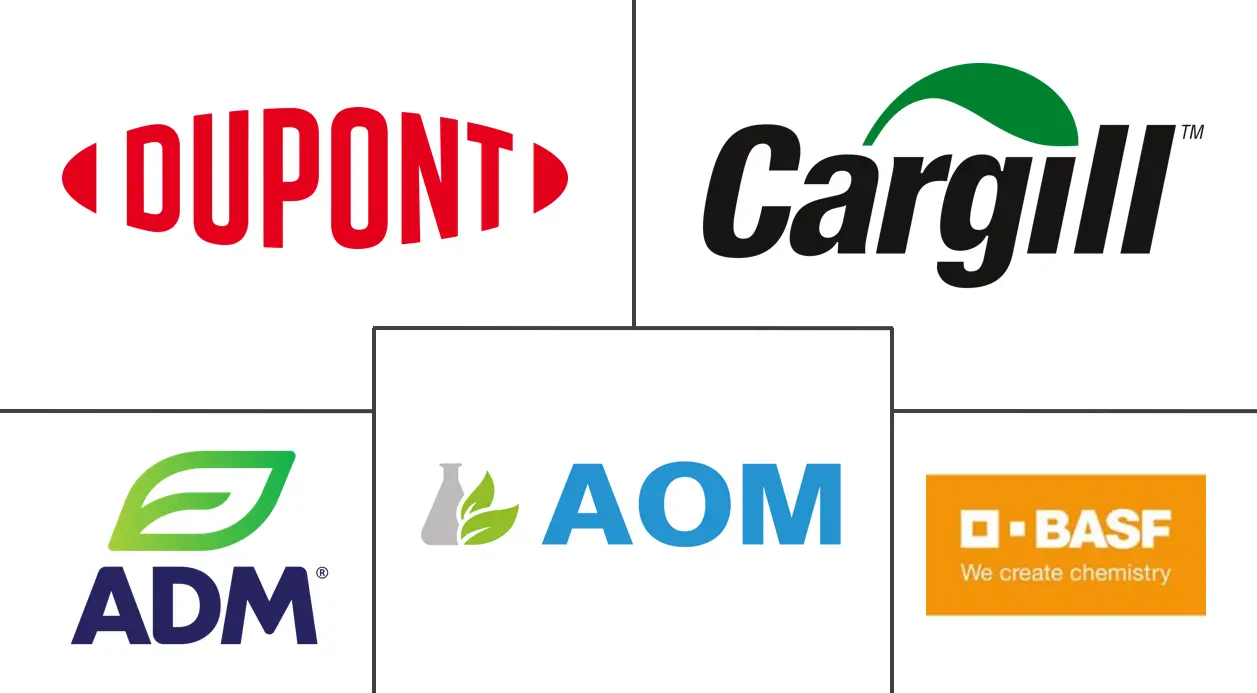Market Size of Food Fortifying Agents Industry

| Study Period | 2019 - 2029 |
| Base Year For Estimation | 2023 |
| CAGR | 7.50 % |
| Fastest Growing Market | Asia Pacific |
| Largest Market | North America |
| Market Concentration | Low |
Major Players
*Disclaimer: Major Players sorted in no particular order |
Food Fortifying Agents Market Analysis
The global food fortifying agents market is projected to register a CAGR of 7.5% during the forecast period (2022 - 2027).
The outbreak of COVID-19 has a significant impact on food fortifying agents due to the increased consciousness of consumers in selecting food. This inclination towards sustainable, regenerative, plant-based nutrition and demand for foods and beverages with immunity-boosting ingredients drives the need for these products and their constituents. Do It Yourself (DIY) trend has seen massive momentum during Corona times and is expected to continue in the next few years. Considering the rapidly changing market landscape, companies are changing their perspectives on expanding beyond traditional markets. In addition to focusing on widening applications and introducing new product portfolios, most food and beverage companies plan to capture domestic and international markets.
The market is mainly driven by the increase in the growth of the health consciousness of consumers. The support of government organizations has also fueled the market growth. For instance, the Food and Agricultural Organization (FAO) and the World Health Organization (WHO) have recognized food fortification as one of the critical strategies to reduce widespread malnutrition, particularly in underdeveloped countries.
The vitamin sector accounts for a significant share owing to the rise in diseases such as osteoporosis and rickets due to vitamin deficiency, the increasing healthcare cost, and the growing aging population. On a segmentation front by application, the diet supplements are projected to have the fastest growth during the forecast period due to their health benefits. They are mainly targeted by the increase in the aging population and interest in personal fitness.
Food Fortifying Agents Industry Segmentation
Fortifying food agents include vitamins and minerals and, in some cases, essential amino acids and proteins, which help boost their nutritional value and benefit health. The global food fortifying agents market has been segmented by types, which include proteins & amino acids, vitamins, lipids, prebiotics & probiotics, carbohydrates, minerals, and others. Based on application, the market is segmented into infant formula, dairy & dairy-based products, cereals & cereal-based products, fats & oils, beverages, dietary supplements, and others, and by geography, the market is segmented into North America, Europe, Asia-Pacific, South America, and the Middle East and Africa. The report offers market size and forecasts for food fortifying agents in Value (USD million) for all the above segments.
| By Type | |
| Proteins & amino acids | |
| Vitamins | |
| Lipids | |
| Prebiotics & probiotics | |
| Carbohydrates | |
| Minerals | |
| Others |
| By Application | |
| Infant formula | |
| Dairy & Dairy-Based Products | |
| Cereals & cereal-based products | |
| Fats & oils | |
| Beverages | |
| Dietary supplements | |
| Others |
| Geography | |||||||||
| |||||||||
| |||||||||
| |||||||||
| |||||||||
|
Food Fortifying Agents Market Size Summary
The food fortifying agents market is experiencing significant growth, driven by increasing consumer health consciousness and a shift towards sustainable, plant-based nutrition. The COVID-19 pandemic has heightened awareness around immunity-boosting ingredients, further propelling demand for fortified foods and beverages. Companies are expanding their focus beyond traditional markets, introducing new product portfolios and targeting both domestic and international markets. Government support, particularly from organizations like the FAO and WHO, has been instrumental in promoting food fortification as a strategy to combat malnutrition, especially in underdeveloped regions. The vitamin sector, in particular, is gaining traction due to the prevalence of vitamin deficiency-related diseases and the growing aging population.
The Asia-Pacific region is anticipated to be the fastest-growing market, with countries like China and India leading due to rising disposable incomes and urbanization. The market is highly competitive, with major players such as Cargill Incorporated, Archer Daniels Midland Company, and BASF SE focusing on strategic mergers, acquisitions, and partnerships to enhance their market presence. The demand for diet supplements is also on the rise, driven by health benefits and the increasing interest in personal fitness. Frequent product launches, such as vitamin-infused snacks and beverages, are expected to further stimulate market growth, addressing nutritional deficiencies while complementing dietary improvement strategies.
Food Fortifying Agents Market Size - Table of Contents
-
1. MARKET DYNAMICS
-
1.1 Market Drivers
-
1.2 Market Restraints
-
1.3 Porter's Five Forces Analysis
-
1.3.1 Threat of New Entrants
-
1.3.2 Bargaining Power of Buyers/Consumers
-
1.3.3 Bargaining Power of Suppliers
-
1.3.4 Threat of Substitute Products
-
1.3.5 Intensity of Competitive Rivalry
-
-
-
2. MARKET SEGMENTATION
-
2.1 By Type
-
2.1.1 Proteins & amino acids
-
2.1.2 Vitamins
-
2.1.3 Lipids
-
2.1.4 Prebiotics & probiotics
-
2.1.5 Carbohydrates
-
2.1.6 Minerals
-
2.1.7 Others
-
-
2.2 By Application
-
2.2.1 Infant formula
-
2.2.2 Dairy & Dairy-Based Products
-
2.2.3 Cereals & cereal-based products
-
2.2.4 Fats & oils
-
2.2.5 Beverages
-
2.2.6 Dietary supplements
-
2.2.7 Others
-
-
2.3 Geography
-
2.3.1 North America
-
2.3.1.1 United States
-
2.3.1.2 Canada
-
2.3.1.3 Mexico
-
2.3.1.4 Rest of North America
-
-
2.3.2 Europe
-
2.3.2.1 Spain
-
2.3.2.2 United Kingdom
-
2.3.2.3 Germany
-
2.3.2.4 France
-
2.3.2.5 Italy
-
2.3.2.6 Russia
-
2.3.2.7 Rest of Europe
-
-
2.3.3 Asia-Pacific
-
2.3.3.1 China
-
2.3.3.2 Japan
-
2.3.3.3 India
-
2.3.3.4 Australia
-
2.3.3.5 Rest of Asia-Pacific
-
-
2.3.4 South America
-
2.3.4.1 Brazil
-
2.3.4.2 Argentina
-
2.3.4.3 Rest of South America
-
-
2.3.5 Middle-East and Africa
-
2.3.5.1 South Africa
-
2.3.5.2 United Arab Emirates
-
2.3.5.3 Rest of Middle-East and Africa
-
-
-
Food Fortifying Agents Market Size FAQs
What is the current Food Fortifying Agents Market size?
The Food Fortifying Agents Market is projected to register a CAGR of 7.5% during the forecast period (2024-2029)
Who are the key players in Food Fortifying Agents Market?
Cargill Incorporated, Archer Daniels Midland Company, BASF SE, DuPont and Advanced Organic Materials, S.A. are the major companies operating in the Food Fortifying Agents Market.

